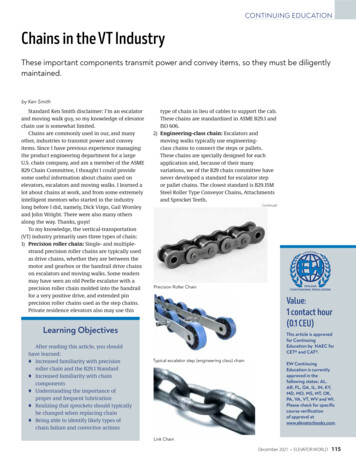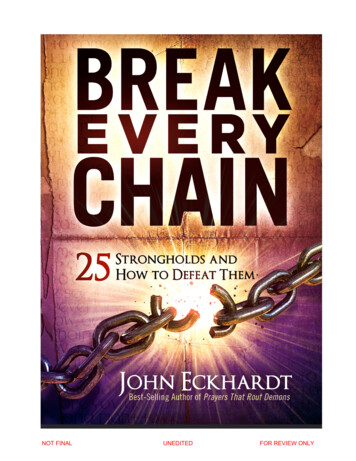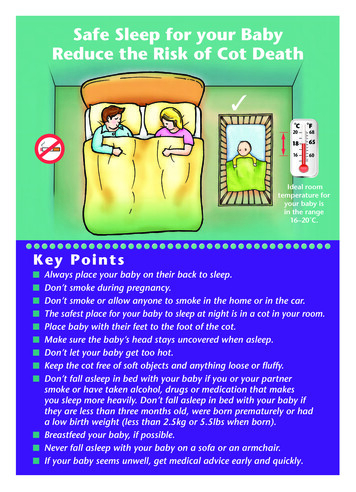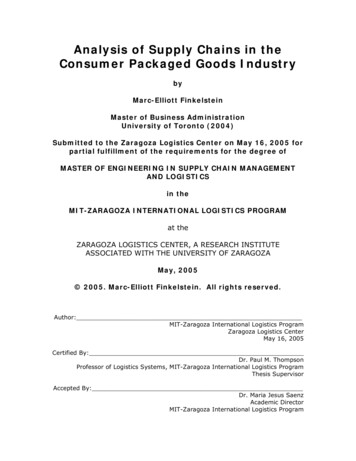
Transcription
CONTINUING EDUCATIONChains in the VT IndustryThese important components transmit power and convey items, so they must be diligentlymaintained.by Ken SmithStandard Ken Smith disclaimer: I’m an escalatorand moving walk guy, so my knowledge of elevatorchain use is somewhat limited.Chains are commonly used in our, and manyother, industries to transmit power and conveyitems. Since I have previous experience managingthe product engineering department for a largeU.S. chain company, and am a member of the ASMEB29 Chain Committee, I thought I could providesome useful information about chains used onelevators, escalators and moving walks. I learned alot about chains at work, and from some extremelyintelligent mentors who started in the industrylong before I did, namely, Dick Virgo, Gail Worsleyand John Wright. There were also many othersalong the way. Thanks, guys!To my knowledge, the vertical-transportation(VT) industry primarily uses three types of chain:1) Precision roller chain: Single- and multiplestrand precision roller chains are typically usedas drive chains, whether they are between themotor and gearbox or the handrail drive chainson escalators and moving walks. Some readersmay have seen an old Peelle escalator with aprecision roller chain molded into the handrailfor a very positive drive, and extended pinprecision roller chains used as the step chains.Private residence elevators also may use thistype of chain in lieu of cables to support the cab.These chains are standardized in ASME B29.1 andISO 606.2) Engineering-class chain: Escalators andmoving walks typically use engineeringclass chains to connect the steps or pallets.These chains are specially designed for eachapplication and, because of their manyvariations, we of the B29 chain committee havenever developed a standard for escalator stepor pallet chains. The closest standard is B29.15MSteel Roller Type Conveyor Chains, Attachmentsand Sprocket Teeth.ContinuedPrecision Roller ChainValue:1 contact hour(0.1 CEU)Learning ObjectivesAfter reading this article, you shouldhave learned: Increased familiarity with precisionroller chain and the B29.1 Standard Increased familiarity with chaincomponents Understanding the importance ofproper and frequent lubrication Realizing that sprockets should typicallybe changed when replacing chain Being able to identify likely types ofchain failure and corrective actionsOnlineContinuing EducationThis article is approvedfor ContinuingEducation by NAEC forCET and CAT .Typical escalator step (engineering class) chainEW ContinuingEducation is currentlyapproved in thefollowing states: AL,AR, FL, GA, IL, IN, KY,MD, MO, MS, MT, OK,PA, VA, VT, WV and WI.Please check for specificcourse verificationof approval atwww.elevatorbooks.com.Link ChainDecember 2021 ELEVATOR WORLD115
CONTINUING EDUCATIONChain Components3) Link chain: I have only seen link chains used on someelevators, and I am not planning on discussing them in thisarticle.Roller chain has been around for more than 140 years; it waspatented in 1880. Development of roller chain began in earnestas bicycles, motorcycles, automobiles and airplanes wereintroduced. As requirements for roller chain increased, so didthe automation of its manufacture. These precision roller chainswere standardized in 1930 by the American StandardsAssociation (now ANSI — the American National StandardsInstitute) in ASA B29a. This standard later became ASME B29.1.Over time, sprocket requirements, horsepower tables and, morerecently, minimum ultimate tensile and dynamic strengthrequirements, have been added.Precision roller chain, shown in the photo at left, andengineering-class chain consist of commonly namedcomponents: inner and outer plates or links, pins, bushings androllers. Rollers, bushings and the inner links form what thechain industry calls a roller link. The roller link is held togetherby the bushings press-fit into the inner links. Note that someengineering class chains have flats on the ends of the bushingsto keep them from rotating in the link. The pins are also pressfit into the outer links. The pin ends are typically staked on theends for “insurance.” Some chains have cotter pins or snap ringsperforming a similar function.Chain integrity is due to the press fit of the components intothe links. The holes in the link plates are almost alwayspunched. The better the quality of this hole, as far as consistentdiameter and taper, the heat treat of the link and consistentdiameter of the pins or bushings, among other things, thebetter the quality of the chain. Lower-quality chain tends tohave poor-quality holes, varying diameters of round parts andinconsistent heat treat. The old saying often attributed toBenjamin Franklin, “The bitterness of poor quality remains longafter the sweetness of low price is forgotten,” certainly appliesContinuedhere.Table 1: ANSI/ASME B29.1 Precision Roller Chain Dimensions116www.elevatorworld.com December 2021
CONTINUING EDUCATIONANSI and ISO Precision Roller Chain DimensionsChain No. Pitch P Max roller dia Dr Nominal width W Nominal pin dia Dp Link plate thickness 0.0700.1400.158Table 2: ANSI and ISO Chain Dimension ComparisonPrecision Roller Chain Numbering System andDimensionsIn ASME B29.1 and every chain manufacturer’s catalog that Ihave ever seen, there is a table substantially similar to the oneon the previous page (Table 1) giving the nominal dimensions ofeach size of precision roller chain. These chains are quite nicelydesigned with the major component dimensions of each sizechain proportional to the pitch (distance between rollers). Thenumbering system of these chains is based on pitch in 1/8 in.increments, for example: 60 chain is 6/8- or 3/4-in. pitch. Therighthand number is typically “0,” but can be “1” for alightweight chain (like 41) or “5” for a rollerless chain (like 25and 35). I have never seen lightweight or rollerless chain usedin our industry; however, there may be a door operator or twothat I have not seen. The B29.1 standard and catalogs alsocontain charts showing the allowable horsepower for eachchain size based on sprocket size and type of lubrication. B29.1also covers sprocket design for these chains.The International Organization for Standardization (ISO)developed ISO 606 short-pitch transmission precision rollerchains and chain wheels. ISO 606 is another standard coveringprecision roller chain. Like B29.1, ISO 606 numbers the chains bypitch. However, they are numbered in 1/16-in. increments.Therefore, 60 chain would be 12 A, with the “A” denoting ANSIchains. There are also “B” series chains that are the same pitchbut have some slightly different dimensions, as the “B” seriesrepresents the British Standards Institute (BSI) chains.I have made a comparison above (Table 2) to show thedimensional differences between the ANSI B29.1 (ISO A series)and the BSI (ISO B series) chains:As you can see, there are differences, albeit minor ones. Imanufacture a chain breaker and, for this application, the rollerand pin diameters and inside-width differences from ANSIchain are important to account for. For most applications,120www.elevatorworld.com December 2021different sprockets and strength must be taken into account. Ihave not seen many “B” series chains in North America, outsideof food-industry machinery and some agricultural equipment,but I’m sure they are coming.One of the first things that I would like to address is thecommon use of the term “chain stretch.” For you scientific typesout there, we know that, when loaded below its componentsyield strength, a chain will elongate, and then come back toapproximately its original length (I suppose you could call thisstretch). An example would be measuring chain length,measuring it again when someone gets into a private-residenceelevator car and measuring it yet again when they get out(assuming chain is supporting the car). If a chain is loadedbeyond its yield strength, it will be longer than its originallength without the load. If the load is great enough, the chainwill fail or break.Good-quality, precision roller chains are preloaded at thefactory during the assembly process. The process varies, but asignificant load is applied to the chain during manufacture,which causes the chain to lengthen slightly. Preloadingminimizes or eliminates the initial elongation of a nonpreloaded chain and increases the fatigue strength of the chain.A high preload is necessary on chain used in highly loadedapplications.The phrase chain stretch is commonly — and incorrectly —used to describe wear. As chain articulates under load, itundergoes wear, not stretch. The wear occurs between the pinand bushing of the chain, and is not visible unless the chain, orconnector link, is disassembled. Chain will wear faster if notadequately lubricated, contaminated with abrasive material(dirt, sand, concrete dust, etc.) or run at higher-thanrecommended loads.Chain drives will accept a small amount of chain elongation,typically 2-3%, before the chain needs to be replaced. TheContinued
CONTINUING EDUCATIONamount of acceptable elongation depends on things like theorientation of the drive. For example, a Montgomery solidbalustrade escalator typically has a near-vertical chain drive. Itwill accept approximately 2% elongation before you considerreplacement. A Montgomery glass balustrade escalator has anear-horizontal drive and should accept approximately 3%elongation before the chain requires replacement. Thesenumbers are somewhat conservative but are a good rule ofthumb. Some chain manufacturers can provide chain weargauges, or you can just measure pin to pin over as long astraight stretch as you can, then compare this length to thenominal pitch (distance from pin to pin). Percent elongation is[(measured length-nominal length)/nominal length]. Precisionroller chain pitch, dimensions, and other useful information isin B29.1 (I suggest you buy a copy from ASME and help supportthe standard).Measuring chainEngineering-class chain is a different animal, running atdifferent speeds and loads. Because it typically connects stepsor pallets, step/pallet mesh (or lack of) is usually the criteria forreplacement. In all the cases that I am aware of, step/palletchain is replaced before it reaches even 1% elongation.If a chain has elongated too much prior to being replaced, itcan begin to hop the sprocket teeth. When this occurs, thechain (and sprockets) should be replaced immediately.sprocket wear that will affect chain life. However, you can seean excessively worn sprocket: Typically, the tooth is “hooked” orappears to be bent.For drive chains, I recommend changing the sprockets whenyou change the chain. For step/pallet chains, this is unlikelyunless visible wear is noted on the tooth. Way back in the ’80sat Montgomery, we machined a plug gauge to check the toothwear on bull gear sprockets. Putting a new chain on wornsprockets is like changing your car’s oil but not the filter.LubricationTo be effective in prolonging chain life, lubricant mustpenetrate into the chain’s pin/bushing area (similar to a journalbearing), as shown in the image below. Lubricant applied to therest of the chain will help protect the links and rollers fromcorrosion but will not help with elongation of the chain. Inpractice, it can be somewhat difficult getting oil into the smallgap between the inner and outer links.Every application that I have seen in our industry, with thecaveat that I haven’t seen them all, is fine with Type A drip ormanual lubrication, due to the sprocket size and speed (RPM) ofthe drive. The horsepower tables for precision roller chainfound in B29.1 or manufacturers’ catalogs provide informationon lubrication type required.Most, if not all, equipment manufacturers haverecommendations for the particular chain oil, or specificationsfor the type of lubricant they recommend on their products. Itpays to follow the manufacturer’s recommendations. I’m amotorcycle nut, so one example of incorrect lubrication thatcomes to mind was when O-ring chains came out formotorcycles. Many of these chains were ruined in short order bypeople applying conventional chain lubes to them thatdestroyed the O-rings.Castrol is marketing a new product for escalators andmoving walks that uses a carrier to get dry film lubricant intothe pin/bushing area. Their testing looks quite promising.New (left) and “hooked tooth” (right) sprocketsSprocket replacement: I can almost hear all of the mechanicsgoing “AARGH!” as they read this. Chain engineers like to seesprockets replaced when chain is replaced, unless the chain isreplaced with a very small amount of elongation. Chainsalesman like new chain on old sprockets because you will haveto replace the chain more frequently. As a chain wears, so dothe sprockets. This changes the profile of the sprocket tooth andaffects how the chain interacts with the sprockets. When a newchain is placed on worn sprockets, it will elongate faster. Notethat it is difficult, if not impossible, to see the amount ofProper lubrication applicationTypical Chain Failures in the VT IndustryThe most common problem with chain that I see when I aminspecting equipment is inadequate lubrication. Someequipment relies on manual lubrication of the chain, and somehas automatic oilers. I have seen many escalators and movingwalks with chains that have inadequate lubrication. Manytimes, they are easily identified by fretting corrosion — red rust— seen on the links around the pin/bushing joints. Note thatContinued122www.elevatorworld.com December 2021
CONTINUING EDUCATIONLearning-Reinforcement QuestionsUse the below learning-reinforcement questions to studyfor the Continuing Education Assessment Exam availableonline at www.elevatorbooks.com or on p. 134 of this issue. What are the three types of chain primarily used in thevertical-transportation industry? What is the difference between the common use of theterm “chain stretch” and wear? To be effective in prolonging chain life, what area mustlubrication penetrate? What does it mean for a chain to have “tight joints”? What is the criteria for replacing an engineering classchain?the best photo I could find for fretting is on the links of a leafchain, not a roller chain.FrettingOnce fretting occurs, chain life has been reducedconsiderably. Most precision roller chains have carburized orcarbonitrided pins and bushings. They have a thin but veryhard layer on the surface to minimize wear. Once a chain hasrun without lubrication and frets, this layer can be quite worn.If it wears through, the chain elongates quite rapidly. Note thatlack of lubrication can cause the sprockets to wear fasterthan usual.Chain rusting fromenvironmental conditions isalso a typical issue, especiallyfor equipment that is outdoorsin humid and/or saltyenvironments.Worn PinRusty step chainAnother problem I have seen is known as “tight joints,” asshown in the photo below. When a chain has tight joints, thechain won’t straighten out when under load, or is hard to bendby hand. Typically, in our industry, this is caused by inadequatelubrication and/or corrosion in the pin/bushing joint. If thechain has tight joints, it must be replaced.Tight jointsIn all my years in the industry, I have only seen “turned pins”once. The phenomenon can be identified by the unalignedstakes or swedges on the end of the pins. The press fit betweenthe pin(s) and link(s) is overcome and the pin(s) turn whenarticulating over the sprocket. This is usually due to inadequatelubrication and/or overloading. If a chain has turned pins, itmust be replaced.I have never seen escalatoror moving walk chain withbroken link plates unless theywere broken due to stresscorrosion. However, chain canfail in this manner. Typically, inthe case of step/pallet chain, itTurned pinswould be the inner link platethat would fail from an overload because it usually has across-sectional area around the bushing that is smaller than theouter link has around the pin. On a precision roller chain, itcould be either the inner or outer link. Obviously, if a chain hasbroken links, it must be replaced (after fishing it out of the mostinaccessible place possible).Chains can also fail fromfatigue. If a well-made chain isapplied per the manufacturer’srecommendations, fatiguefailure is rare. Usually, chainsfail from wear. A chain can failin fatigue if it is operated athigh load in a certain numberBroken link (from tensile overload)of load cycles. The link platescrack from the pin hole to the outside edge, as shown in thephoto below. This instruction is becoming repetitive — thechain must be replaced.Broken pins can also occurfrom a tensile overload.During a step crash, escalatoror moving walk step/palletchain can experience pinfailure. Some chains haveextended pins to secure thesteps/pallets or their axles.Broken link (from fatigue)124www.elevatorworld.com December 2021Continued
CONTINUING EDUCATIONAccounting of Time For Article:Opening (15 minutes) Precision roller chain Engineering-class chain Link chainPrecision Roller Chain Numbering System andDimensions (15 minutes)Lubrication (15 minutes)Typical Chain Failures in the VT Industry (15 minutes) SummaryThese extended pins aresometimes designed to breakoff, saving the unit from moreextensive damage. Again, thechain must be replaced.Finally, we come to stresscorrosion. Steel that ishardened to a certain level, asBroken pinsome chain links are, can faildue to stress corrosion. Typically, if the chain is exposed tomoisture or a chemical that causes the chain link to corrode,this, along with the stress from the press fit, can cause the linkto crack (usually the pin or outer link). This is a relatively rarephenomenon, but I have examined escalator and moving walkstep chains that have failed in this manner. The chain must bereplaced and, to avoid reoccurrence of the problem, theenvironmental causes must be eliminated.SummaryIf you’ve noticed a commonthread to potential chainproblems in our industry, it’s thatmost are due to a lack oflubrication. Rarely is overloadinga factor, since equipment isStress corrosiondesigned using the ASME A17.1Safety Code for Elevators and Escalators factors of safety. Notethat there are some lube-free chains out there, too.Lubrication is critical to achieve a reasonable life-expectancyand to protect the chain from corrosion. My advice: get outthere with your oil can and lube those chains!ReferencesIf you need more information on chain, I would like tosuggest that you review the ASME B29 chain standards for theparticular chain in which you are interested, or the ISO chainstandards. In addition, the American Chain Associationpublished a fantastic book, the “Standard Handbook of Chains,Second Edition.” This book is available on the ConveyorEquipment Manufacturer’s Association (CEMA) website, www.cemastore.com.Ken Smith is a mechanical engineer specializingin the design, installation and maintenance ofescalators and moving walks. Smith received hisBS in Mechanical Engineering from the Universityof Iowa in 1985 and began his career withMontgomery Elevator in 1985 as a projectengineer. In 1992, he went to Drives Inc. asproduct engineering manager, then returned toKONE in 2000 as manager of Engineering Services.He began working full time at his consulting firm,Ken Smith & Associates LLC, in 2003, and has more recently become apartner in eMCP, LLC. He holds patents in the U.S. and internationally. Heis a member of the ASME A17 Escalator and Moving Walk and B29 Chaincommittees.126www.elevatorworld.com December 2021
may have seen an old Peelle escalator with a precision roller chain molded into the handrail for a very positive drive, and extended pin precision roller chains used as the step chains. Private residence elevators also may use this type of chain in lieu of cables to support the cab. These chains are standardized in ASME B29.1 and ISO 606.










